## 用Wpf做一个可编程画板(续4-Diagram画板)
Posted WPF学习分享
tags:
篇首语:本文由小常识网(cha138.com)小编为大家整理,主要介绍了## 用Wpf做一个可编程画板(续4-Diagram画板)相关的知识,希望对你有一定的参考价值。
先上一张效果动图。
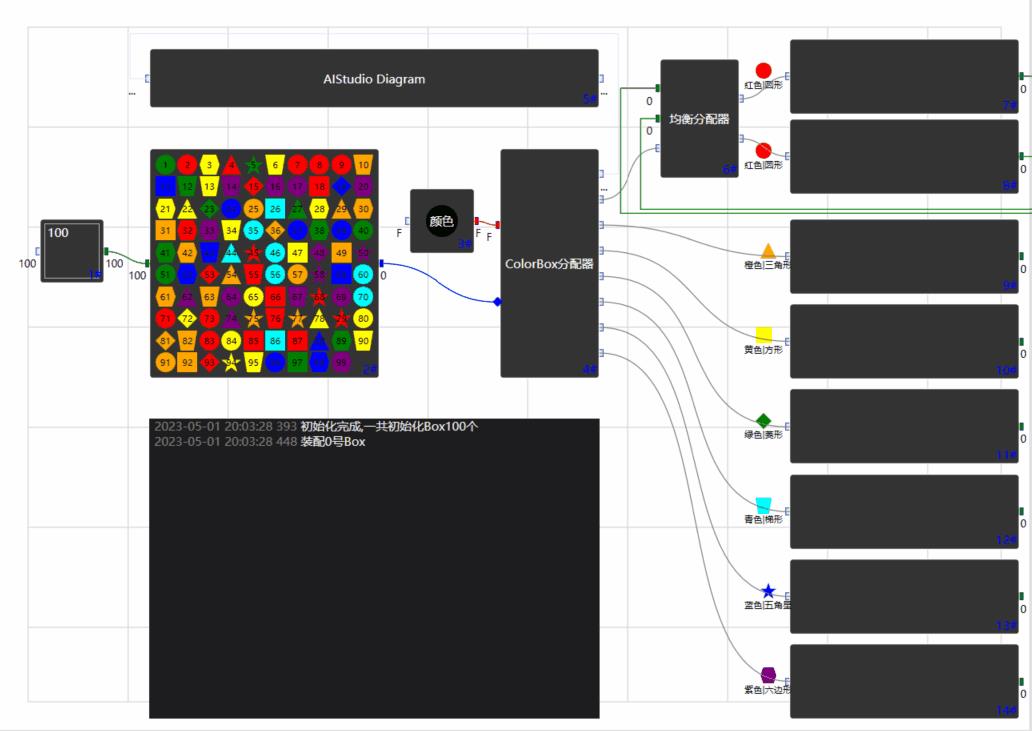
同样老规矩,先上源码地址:https://gitee.com/akwkevin/aistudio.-wpf.-diagram
自定义一个text模块的代码如下:
Code = @"using System;
namespace AIStudio.Wpf.CSharpScript
public class Writer
public string StringValue get; set; = ""Welcome to AIStudio.Wpf.Diagram"";
public string Execute()
return StringValue;
";
是不是很简单。
本次扩展的主要内容
1.可编程模块,使用C#语言。 2.控制台打印控件,可以打印程序中的Console.WriteLine数据 3.为了便于大家使用,写了一个Box工厂分配Box的数据流向效果图。
可编程模块的实现原理
使用Microsoft.CodeAnalysis.CSharp.Scripting对代码进行编译,生成Assembly,然后对Assembly反射获得对象,对象内部固定有一个Execute方法,每次扫描的时候执行即可。 1.编译使用的Using,必须添加引用集,为了省事,把整个程序的Reference都放入进行编译,获得引用的核心代码如下:
var references = AppDomain.CurrentDomain.GetAssemblies().Where(p => !p.IsDynamic && !string.IsNullOrEmpty(p.Location)).Select(x => MetadataReference.CreateFromFile(x.Location)).ToList();
//Costura.Fody压缩后,无Location,读取资源文件中的reference
foreach (var assemblyEmbedded in AppDomain.CurrentDomain.GetAssemblies().Where(p => !p.IsDynamic && string.IsNullOrEmpty(p.Location)))
using (var stream = Assembly.GetEntryAssembly().GetManifestResourceStream($"costura.assemblyEmbedded.GetName().Name.ToLowerInvariant().dll.compressed"))
if (stream != null)
using (var compressStream = new DeflateStream(stream, CompressionMode.Decompress))
var memStream = new MemoryStream();
CopyTo(compressStream, memStream);
memStream.Position = 0;
references.Add(MetadataReference.CreateFromStream(memStream));
2.动态编译的代码的核心代码如下:
public static Assembly GenerateAssemblyFromCode(string code, out string message)
Assembly assembly = null;
message = "";
// 丛代码中转换表达式树
SyntaxTree syntaxTree = CSharpSyntaxTree.ParseText(code);
// 随机程序集名称
string assemblyName = Path.GetRandomFileName();
// 引用
// 创建编译对象
CSharpCompilation compilation = CSharpCompilation.Create(assemblyName, new[] syntaxTree , References, new CSharpCompilationOptions(OutputKind.DynamicallyLinkedLibrary));
using (var ms = new MemoryStream())
// 将编译好的IL代码放入内存流
EmitResult result = compilation.Emit(ms);
// 编译失败,提示
if (!result.Success)
IEnumerable<Diagnostic> failures = result.Diagnostics.Where(diagnostic =>
diagnostic.IsWarningAsError ||
diagnostic.Severity == DiagnosticSeverity.Error).ToList();
foreach (Diagnostic diagnostic in failures)
message += $"diagnostic.Id: diagnostic.GetMessage()";
Console.WriteLine(message);
else
// 编译成功,从内存中加载编译好的程序集
ms.Seek(0, SeekOrigin.Begin);
assembly = Assembly.Load(ms.ToArray());
return assembly;
3.获得编译后的程序集,以及执行。
// 反射获取程序集中 的类
Type type = assembly.GetTypes().FirstOrDefault(p => p.FullName.StartsWith("AIStudio.Wpf")); //assembly.GetType("AIStudio.Wpf.CSharpScript.Write");
// 创建该类的实例
object obj = Activator.CreateInstance(type);
// 通过反射方式调用类中的方法。
var result = type.InvokeMember("Execute",
BindingFlags.Default | BindingFlags.InvokeMethod,
null,
obj,
new object[] );
代码编辑模块的实现
选择AvalonEdit控件,另外为了使用VS2019_Dark的黑色皮肤,引用官方Demo中的HL和TextEditlib实现自定义换肤。 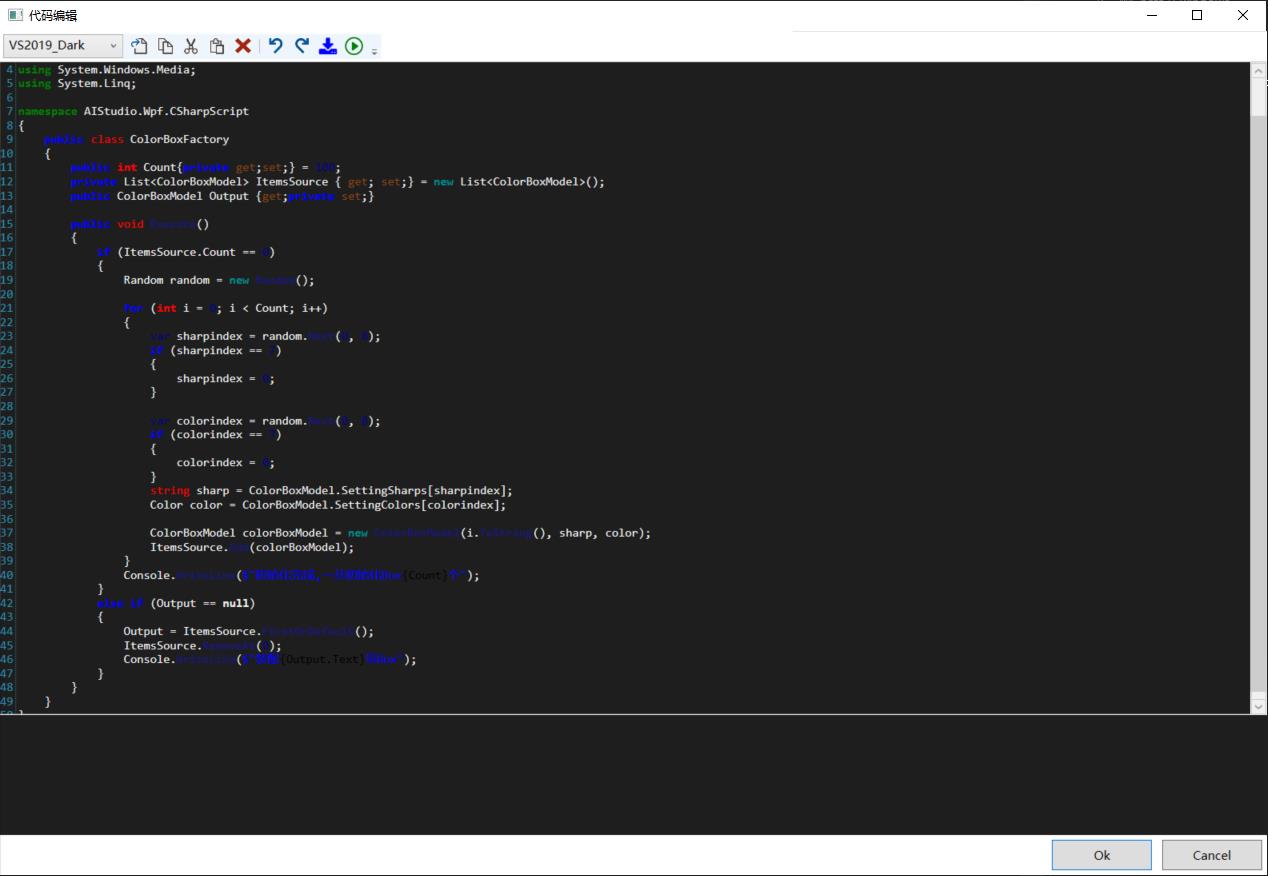 官方Demo的换肤写的超级复杂,看不懂,但是我们只要理解换肤的核心部分就是动态资源字典,因此我简化下,改进后的核心换肤代码如下:
官方Demo的换肤写的超级复杂,看不懂,但是我们只要理解换肤的核心部分就是动态资源字典,因此我简化下,改进后的核心换肤代码如下:
public class TextEditorThemeHelper
static Dictionary<string, ResourceDictionary> ThemeDictionary = new Dictionary<string, ResourceDictionary>();
public static List<string> Themes = new List<string>() "Dark", "Light", "TrueBlue", "VS2019_Dark" ;
public static string CurrentTheme get; set;
static TextEditorThemeHelper()
var resource = new ResourceDictionary Source = new Uri("/TextEditLib;component/Themes/LightBrushs.xaml", UriKind.RelativeOrAbsolute) ;
ThemeDictionary.Add("Light", resource);
resource = new ResourceDictionary Source = new Uri("/TextEditLib;component/Themes/DarkBrushs.xaml", UriKind.RelativeOrAbsolute) ;
ThemeDictionary.Add("Dark", resource);
Application.Current.Resources.MergedDictionaries.Add(resource);
/// <summary>
/// 设置主题
/// </summary>
/// <param name="theme"></param>
public static void SetCurrentTheme(string theme)
OnAppThemeChanged(theme);//切换到VS2019_Dark
CurrentTheme = theme;
/// <summary>
/// Invoke this method to apply a change of theme to the content of the document
/// (eg: Adjust the highlighting colors when changing from "Dark" to "Light"
/// WITH current text document loaded.)
/// </summary>
internal static void OnAppThemeChanged(string theme)
ThemedHighlightingManager.Instance.SetCurrentTheme(theme);
if (ThemeDictionary.ContainsKey(theme))
foreach (var key in ThemeDictionary[theme].Keys)
ApplyToDynamicResource(key, ThemeDictionary[theme][key]);
// Does this highlighting definition have an associated highlighting theme?
else if (ThemedHighlightingManager.Instance.CurrentTheme.HlTheme != null)
// A highlighting theme with GlobalStyles?
// Apply these styles to the resource keys of the editor
foreach (var item in ThemedHighlightingManager.Instance.CurrentTheme.HlTheme.GlobalStyles)
switch (item.TypeName)
case "DefaultStyle":
ApplyToDynamicResource(TextEditLib.Themes.ResourceKeys.EditorBackground, item.backgroundcolor);
ApplyToDynamicResource(TextEditLib.Themes.ResourceKeys.EditorForeground, item.foregroundcolor);
break;
case "CurrentLineBackground":
ApplyToDynamicResource(TextEditLib.Themes.ResourceKeys.EditorCurrentLineBackgroundBrushKey, item.backgroundcolor);
ApplyToDynamicResource(TextEditLib.Themes.ResourceKeys.EditorCurrentLineBorderBrushKey, item.bordercolor);
break;
case "LineNumbersForeground":
ApplyToDynamicResource(TextEditLib.Themes.ResourceKeys.EditorLineNumbersForeground, item.foregroundcolor);
break;
case "Selection":
ApplyToDynamicResource(TextEditLib.Themes.ResourceKeys.EditorSelectionBrush, item.backgroundcolor);
ApplyToDynamicResource(TextEditLib.Themes.ResourceKeys.EditorSelectionBorder, item.bordercolor);
break;
case "Hyperlink":
ApplyToDynamicResource(TextEditLib.Themes.ResourceKeys.EditorLinkTextBackgroundBrush, item.backgroundcolor);
ApplyToDynamicResource(TextEditLib.Themes.ResourceKeys.EditorLinkTextForegroundBrush, item.foregroundcolor);
break;
case "NonPrintableCharacter":
ApplyToDynamicResource(TextEditLib.Themes.ResourceKeys.EditorNonPrintableCharacterBrush, item.foregroundcolor);
break;
default:
throw new System.ArgumentOutOfRangeException("GlobalStyle named \'0\' is not supported.", item.TypeName);
/// <summary>
/// Re-define an existing <seealso cref="SolidColorBrush"/> and backup the originial color
/// as it was before the application of the custom coloring.
/// </summary>
/// <param name="key"></param>
/// <param name="newColor"></param>
private static void ApplyToDynamicResource(ComponentResourceKey key, Color? newColor)
if (Application.Current.Resources[key] == null || newColor == null)
return;
// Re-coloring works with SolidColorBrushs linked as DynamicResource
if (Application.Current.Resources[key] is SolidColorBrush)
//backupDynResources.Add(resourceName);
var newColorBrush = new SolidColorBrush((Color)newColor);
newColorBrush.Freeze();
Application.Current.Resources[key] = newColorBrush;
private static void ApplyToDynamicResource(object key, object newValue)
if (Application.Current.Resources[key] == null || newValue == null)
return;
Application.Current.Resources[key] = newValue;
使用方法: TextEditorThemeHelper.SetCurrentTheme("VS2019_Dark"); 或者 TextEditorThemeHelper.SetCurrentTheme("TrueBlue"); 或者 TextEditorThemeHelper.SetCurrentTheme("Dark"); 或者 TextEditorThemeHelper.SetCurrentTheme("Light"); 是不是超级简单。
代码编辑模块的编译与测试。
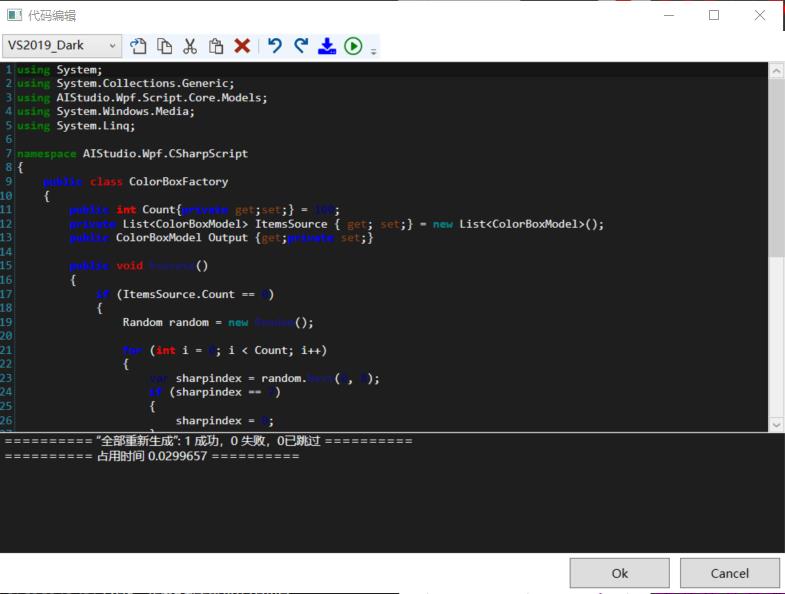
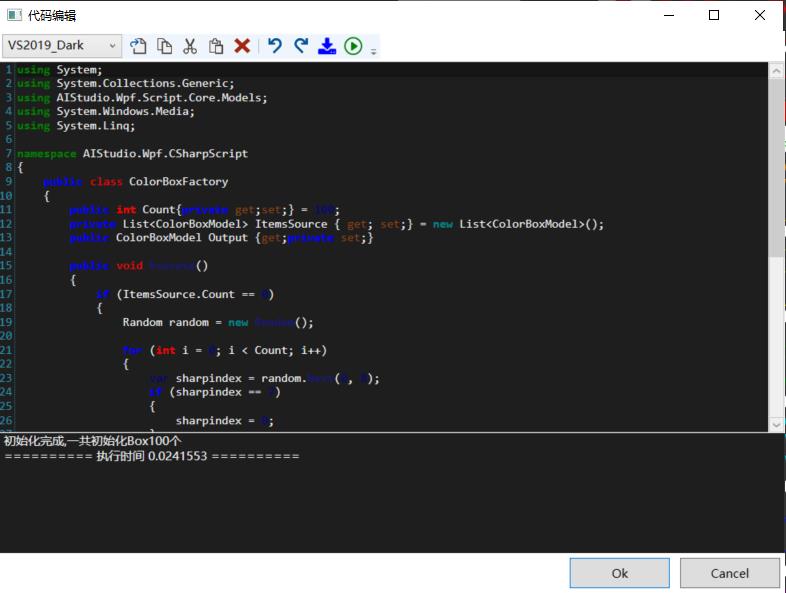
WPF打印控制台数据
控制台打印方法支持切换运行输出方法Console.SetOut,核心代码如下:
public class ConsoleWriter : TextWriter
private readonly Action<string> _Write;
private readonly Action<string> _WriteLine;
private readonly Action<string, string, string, int> _WriteCallerInfo;
public ConsoleWriter()
/// <summary>
/// Console 输出重定向
/// </summary>
/// <param name="write">日志方法委托(针对于 Write)</param>
/// <param name="writeLine">日志方法委托(针对于 WriteLine)</param>
public ConsoleWriter(Action<string> write, Action<string> writeLine, Action<string, string, string, int> writeCallerInfo)
_Write = write;
_WriteLine = writeLine?? write;
_WriteCallerInfo = writeCallerInfo;
/// <summary>
/// Console 输出重定向
/// </summary>
/// <param name="write">日志方法委托(针对于 Write)</param>
/// <param name="writeLine">日志方法委托(针对于 WriteLine)</param>
public ConsoleWriter(Action<string> write, Action<string> writeLine)
_Write = write;
_WriteLine = writeLine;
/// <summary>
/// Console 输出重定向
/// </summary>
/// <param name="write">日志方法委托</param>
public ConsoleWriter(Action<string> write)
_Write = write;
_WriteLine = write;
/// <summary>
/// Console 输出重定向(带调用方信息)
/// </summary>
/// <param name="write">日志方法委托(后三个参数为 CallerFilePath、CallerMemberName、CallerLineNumber)</param>
public ConsoleWriter(Action<string, string, string, int> write)
_WriteCallerInfo = write;
/// <summary>
/// 使用 UTF-16 避免不必要的编码转换
/// </summary>
public override Encoding Encoding => Encoding.Unicode;
/// <summary>
/// 最低限度需要重写的方法
/// </summary>
/// <param name="value">消息</param>
public override void Write(string value)
if (_WriteCallerInfo != null)
WriteWithCallerInfo(value);
return;
_Write(value);
/// <summary>
/// 为提高效率直接处理一行的输出
/// </summary>
/// <param name="value">消息</param>
public override void WriteLine(string value)
if (_WriteCallerInfo != null)
WriteWithCallerInfo(value);
return;
_WriteLine(value);
/// <summary>
/// 带调用方信息进行写消息
/// </summary>
/// <param name="value">消息</param>
private void WriteWithCallerInfo(string value)
//3、System.Console.WriteLine -> 2、System.IO.TextWriter + SyncTextWriter.WriteLine -> 1、DotNet.Utilities.ConsoleHelper.ConsoleWriter.WriteLine -> 0、DotNet.Utilities.ConsoleHelper.ConsoleWriter.WriteWithCallerInfo
var callInfo = ClassHelper.GetMethodInfo(4);
_WriteCallerInfo(value, callInfo?.FileName, callInfo?.MethodName, callInfo?.LineNumber ?? 0);
public override void Close()
var standardOutput = new StreamWriter(Console.OpenStandardOutput());
standardOutput.AutoFlush = true;
Console.SetOut(standardOutput);
base.Close();
使用: ConsoleWriter ConsoleWriter = new ConsoleWriter(_write, _writeLine); Console.SetOut(ConsoleWriter);
动态编译模块的输入输出自动生成。
1.输入输出模块:public string Value get; set; 2.输入模块:public string Valueprivate get; set; 3.输出模块:public string Valueget;private set; 4.与外部交互模块:private string Value get; set; ,必须同名同属性。 核心代码如下:
public static Dictionary<string, List<PropertyInfo>> GetPropertyInfo(Type type)
Dictionary<string, List<PropertyInfo>> puts = new Dictionary<string, List<PropertyInfo>>()
"Input", new List<PropertyInfo>() ,
"Output", new List<PropertyInfo>() ,
"Input_Output", new List<PropertyInfo>() ,
"Inner", new List<PropertyInfo>()
;
try
foreach (System.Reflection.PropertyInfo info in type.GetProperties(BindingFlags.Public | BindingFlags.Instance))
if (info.CanRead && info.CanWrite)
if (info.SetMethod.IsPublic && info.GetMethod.IsPublic)
puts["Input_Output"].Add(info);
else if (info.SetMethod.IsPublic)
puts["Input"].Add(info);
else if (info.GetMethod.IsPublic)
puts["Output"].Add(info);
else if (info.CanRead)
if (info.GetMethod.IsPublic)
puts["Output"].Add(info);
foreach (System.Reflection.PropertyInfo info in type.GetProperties(BindingFlags.NonPublic | BindingFlags.Instance))
if (info.CanRead)
puts["Inner"].Add(info);
catch (Exception ex)
return puts;
最后介绍一下Demo的实现。
1#.Int整数模块,界面定义一个TextBox绑定Int模块的输入管脚。 2#.Box产生模块,如果内部数组为空,那么按照输入管脚的数量初始化一个容量为输入整数数量的数组(随机颜色与形状),然后把数据放到输出管脚,当数据被取走后,下一个数据再次放到输出管脚。 3#.Bool模块,为false的时候按照颜色进行分配,为true的时候按照形状进行分配。 4#.Box分配模块,当输入管脚为空的时候,2#模块的输出可以移动到4#的输入管脚,移动时间为1s,移动完成后,清除2#模块的输出。同时把数据按照颜色或者形状分配到输出,同时把输入管脚清除。 按照颜色分配时: (1.如果颜色为红色,那么输出到1号 (2.如果颜色为橙色,那么输出到2号 (3.如果颜色为黄色,那么输出到3号 (4.如果颜色为绿色,那么输出到4号 (5.如果颜色为青色,那么输出到5号 (6.如果颜色为蓝色,那么输出到6号 (7.如果颜色为紫色,那么输出到7号 按照形状分配时: (1.如果形状为圆形,那么输出到1号 (2.如果形状为三角形,那么输出到2号 (3.如果形状为方形,那么输出到3号 (4.如果形状为菱形,那么输出到4号 (5.如果形状为梯形,那么输出到5号 (6.如果形状为五角星,那么输出到6号 (7.如果形状为六边形,那么输出到7号 6#.有两个红色|圆形收集器(7#,8#),按两个容器中的数量比较反馈,均匀分配到这两个收集器中。 9#,10#,11#,12#,13#,14#按照管脚取走数据即可。
最后选择C#做脚本编辑,对C#程序员比较省事,但是如果需要给一些非专业编程人员使用,还是用python做脚本编辑比较好,下期是不是做这个呢?
WPF 内部Template 动画板 无法冻结此 Storyboard 时间线树供跨线程使用
原文:WPF 内部Template 动画板 无法冻结此 Storyboard 时间线树供跨线程使用
解决此问题,需要一定的想象力。
换个思路即可
大体是
使用Tag或者别无用的可以输入数值的属性,或者附加属性也可以的。来绑定到你要动画的属性
当然这个过程中要使用转换器了
我给出一个关于Button 的Width的内部模板小栗子,各位朋友可以针对自己的项目/控件进行修改
XAML代码
<Window.Resources>
<local:ToCon x:Key="To"/>
<Style x:Key="FocusVisual">
<Setter Property="Control.Template">
<Setter.Value>
<ControlTemplate>
<Rectangle Margin="2" SnapsToDevicePixels="true" Stroke="{DynamicResource {x:Static SystemColors.ControlTextBrushKey}}" StrokeThickness="1" StrokeDashArray="1 2"/>
</ControlTemplate>
</Setter.Value>
</Setter>
</Style>
<SolidColorBrush x:Key="Button.Static.Background" Color="#FFDDDDDD"/>
<SolidColorBrush x:Key="Button.Static.Border" Color="#FF707070"/>
<SolidColorBrush x:Key="Button.MouseOver.Background" Color="#FFBEE6FD"/>
<SolidColorBrush x:Key="Button.MouseOver.Border" Color="#FF3C7FB1"/>
<SolidColorBrush x:Key="Button.Pressed.Background" Color="#FFC4E5F6"/>
<SolidColorBrush x:Key="Button.Pressed.Border" Color="#FF2C628B"/>
<SolidColorBrush x:Key="Button.Disabled.Background" Color="#FFF4F4F4"/>
<SolidColorBrush x:Key="Button.Disabled.Border" Color="#FFADB2B5"/>
<SolidColorBrush x:Key="Button.Disabled.Foreground" Color="#FF838383"/>
<Style x:Key="ButtonStyle1" TargetType="{x:Type Button}">
<Setter Property="FocusVisualStyle" Value="{StaticResource FocusVisual}"/>
<Setter Property="Background" Value="{StaticResource Button.Static.Background}"/>
<Setter Property="BorderBrush" Value="{StaticResource Button.Static.Border}"/>
<Setter Property="Foreground" Value="{DynamicResource {x:Static SystemColors.ControlTextBrushKey}}"/>
<Setter Property="BorderThickness" Value="1"/>
<Setter Property="HorizontalContentAlignment" Value="Center"/>
<Setter Property="VerticalContentAlignment" Value="Center"/>
<Setter Property="Padding" Value="1"/>
<Setter Property="Template">
<Setter.Value>
<ControlTemplate TargetType="{x:Type Button}">
<ControlTemplate.Resources>
<local:ToCon x:Key="ToConHeight"/>
</ControlTemplate.Resources>
<Border Height="{Binding Tag,RelativeSource={RelativeSource Mode=Self}, Converter={ StaticResource ToConHeight }}" x:Name="border" BorderBrush="{TemplateBinding BorderBrush}" BorderThickness="{TemplateBinding BorderThickness}" Background="{TemplateBinding Background}" SnapsToDevicePixels="true">
<Border.Tag>
<Binding Path="Tag" RelativeSource="{RelativeSource Mode=TemplatedParent}" Converter="{StaticResource ToConHeight }"/>
</Border.Tag>
<ContentPresenter x:Name="contentPresenter" Focusable="False" HorizontalAlignment="{TemplateBinding HorizontalContentAlignment}" Margin="{TemplateBinding Padding}" RecognizesAccessKey="True" SnapsToDevicePixels="{TemplateBinding SnapsToDevicePixels}" VerticalAlignment="{TemplateBinding VerticalContentAlignment}"/>
</Border>
<ControlTemplate.Triggers>
<Trigger Property="IsDefaulted" Value="true">
<Setter Property="BorderBrush" TargetName="border" Value="{DynamicResource {x:Static SystemColors.HighlightBrushKey}}"/>
</Trigger>
<Trigger Property="IsMouseOver" Value="true">
<Trigger.EnterActions>
<BeginStoryboard>
<Storyboard>
<DoubleAnimation Storyboard.TargetProperty="Tag" To="200" Duration="0:0:2"/>
</Storyboard>
</BeginStoryboard>
</Trigger.EnterActions>
</Trigger>
<Trigger Property="IsPressed" Value="true">
<Setter Property="Background" TargetName="border" Value="{StaticResource Button.Pressed.Background}"/>
<Setter Property="BorderBrush" TargetName="border" Value="{StaticResource Button.Pressed.Border}"/>
</Trigger>
<Trigger Property="IsEnabled" Value="false">
<Setter Property="Background" TargetName="border" Value="{StaticResource Button.Disabled.Background}"/>
<Setter Property="BorderBrush" TargetName="border" Value="{StaticResource Button.Disabled.Border}"/>
<Setter Property="TextElement.Foreground" TargetName="contentPresenter" Value="{StaticResource Button.Disabled.Foreground}"/>
</Trigger>
</ControlTemplate.Triggers>
</ControlTemplate>
</Setter.Value>
</Setter>
</Style>
</Window.Resources>
<Grid>
<Button Style="{DynamicResource ButtonStyle1}" Tag="{Binding Width ,
RelativeSource={RelativeSource Mode=Self},
Converter={StaticResource ResourceKey=To}}" Width="100" Background="Red">
</Button>
</Grid>
转换器
public class ToCon : IValueConverter { public object Convert(object value, Type targetType, object parameter, CultureInfo culture) { if (value == null) return 0; return double.Parse(value.ToString()); } public object ConvertBack(object value, Type targetType, object parameter, CultureInfo culture) { return value.ToString(); } } }
截图
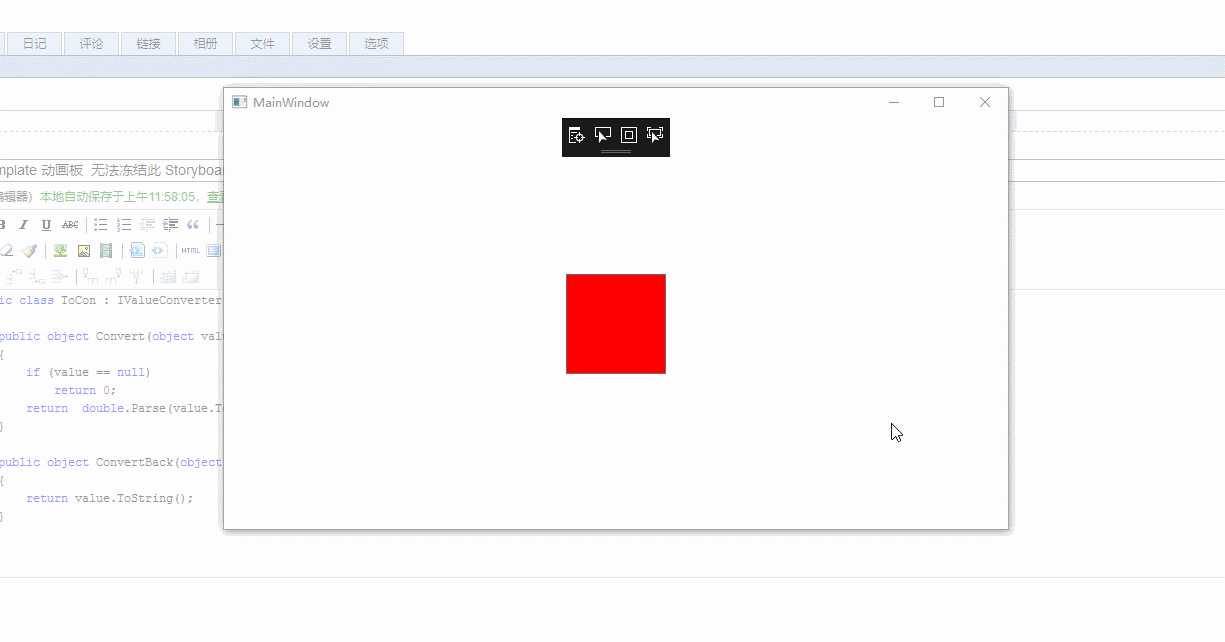
以上是关于## 用Wpf做一个可编程画板(续4-Diagram画板)的主要内容,如果未能解决你的问题,请参考以下文章
